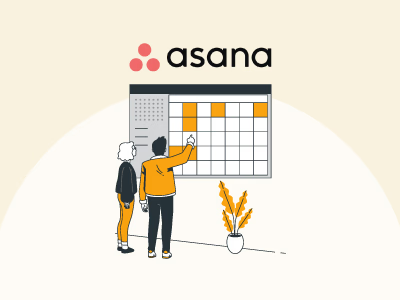Task management is essential for productivity, ensuring every to-do task is organized, prioritized, and monitored effectively. Whether managing a personal project or organizing a team's workload, good task management can help you avoid missed deadlines, miscommunication, and workflow bottlenecks.
With the right task management platform, you can turn cluttered to-do lists into structured plans that improve focus and accountability. Asana is a software that makes task management easier through enhanced communication, streamlined workflows, and boosting overall transparency. This article will guide you through using Asana for task management, ensuring your projects run smoothly from start to finish.

To start using Asana, sign up for a free or premium account. Once logged in, you will see the Asana dashboard offering an intuitive interface. You need to take a moment to familiarize yourself with the dashboard and its key sections, like 'My Tasks,' 'Inbox,' and 'Projects', to efficiently navigate Asana.
Click 'Create Project' at the top to create a new project. You can choose from pre-built templates or create a new one from scratch. Asana offers many project views, including List, Board, Calendar, and Timeline, so you can choose the layout that best suits your task management style. You can customize the project settings by adding team members, setting permissions, and defining objectives to keep everyone on the same page.
To add tasks, go to your project and click 'Add Task’. Here, you can delegate tasks to team members, set deadlines, and break down large tasks into subtasks. Asana's features, like sections, priority tags, and deadlines, smoothen work management by offering a clear structure and timeline.
Asana incorporates advanced features that can greatly enhance task management. You can add custom fields to enter specific data points for tasks, apply tags to easily sort and categorize data, automate repetitive processes, and use Asana's rules and triggers. Asana offers integration with applications like Microsoft Teams, Google Drive, and Slack to streamline workflows and reduce the need for manual updates.
Effective task management involves regular progress tracking. Asana's reporting features offer insights into task completion, project milestones, and team performance. The software's real-time collaboration capabilities enable team members to communicate directly within tasks, share files, and offer updates. This helps reduce the possibility of miscommunication and keeps team members informed on the status of the ongoing task.

Unique Task Automation Capabilities

Asana stands out for its automation features, which enable users to create custom rules that automate routine workflows. These automations eliminate manual effort and streamline repetitive processes, like auto-assigning tasks to certain team members or moving tasks through project stages.
Visual Project Timelines
Asana's Timeline feature gives you a Gantt-chart-style view of your projects, allowing your teams to view task dependencies and project timelines. This assists with planning, modifying schedules, and avoiding possible bottlenecks in task management.
Advanced Reporting And Insights
The platform offers advanced reporting tools that provide detailed productivity insights and track project progress. Its intuitive dashboards and reporting capabilities make it easier to analyze performance metrics, identify areas for improvement, and ensure tasks are aligned with project goals.
Customizable Workflows
One of Asana's unique advantages is its flexible workflow customization. Users can customize projects with custom fields, design unique templates for repetitive tasks, and customize the platform to specific industry demands. This results in a more personalized task management experience.
Seamless Integrations For Extended Functionality
Asana integrates with around 200 apps, including Microsoft Teams, Slack, Google Workspace, and Zapier. These integrations extend Asana's capabilities by allowing data synchronization and improving communication within the tools that your team is already utilizing.
Task management can sometimes be challenging, but Asana makes organizing an efficient and easier process. With features that enhance collaboration, provide deep insights via analytics, and simplify task delegation, Asana assists teams and individuals in maintaining clarity and control over their workload.
By using Asana as your task management solution, you can boost productivity, meet deadlines,
